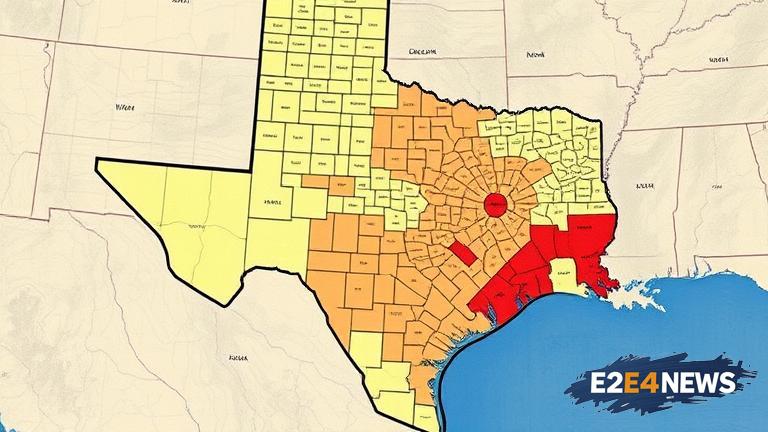The proposed Texas redistricting map has been met with both praise and criticism, as it aims to redefine the state’s congressional boundaries. The new map, which was recently released, could significantly impact the upcoming elections, potentially giving the Republican Party a boost in their chances of winning more seats in Congress. The map has been designed to take into account the state’s growing population and shifting demographics, with the goal of creating more competitive districts. However, some have raised concerns that the map has been gerrymandered to favor Republican candidates, which could lead to a disproportionate representation of the party in Congress. The proposed map has been the subject of intense debate, with some arguing that it is a necessary step to ensure fair representation, while others claim that it is a blatant attempt to manipulate the electoral system. The Texas Legislature is responsible for redrawing the state’s congressional map every 10 years, following the release of new census data. This process is crucial in determining the boundaries of each congressional district, which can have a significant impact on the outcome of elections. The proposed map has been designed to comply with the Voting Rights Act, which prohibits the dilution of minority voting power. However, some have argued that the map does not do enough to protect the rights of minority voters, and that it could potentially lead to a decrease in their representation in Congress. The map has also been criticized for splitting certain communities and cities across multiple districts, which could lead to confusion and disenfranchisement among voters. Despite these concerns, the proposed map has been praised by some for its potential to create more competitive districts, which could lead to a more diverse range of candidates being elected to Congress. The map is expected to be voted on by the Texas Legislature in the coming weeks, and its passage could have significant implications for the state’s electoral landscape. The proposed map is just one example of the ongoing debate over redistricting in the United States, with many states currently engaged in the process of redrawing their congressional boundaries. The outcome of this process will have a significant impact on the balance of power in Congress, and could potentially shape the course of national politics for years to come. The proposed Texas redistricting map has been the subject of intense scrutiny, with many experts and analysts weighing in on its potential implications. Some have argued that the map is a masterclass in gerrymandering, with certain districts being carefully crafted to favor Republican candidates. Others have praised the map for its potential to create more competitive districts, which could lead to a more diverse range of candidates being elected to Congress. The map has also been criticized for its potential impact on minority voters, with some arguing that it could lead to a decrease in their representation in Congress. Despite these concerns, the proposed map is expected to be passed by the Texas Legislature, which could have significant implications for the state’s electoral landscape. The proposed map is a complex and multifaceted issue, with many different factors at play. The outcome of the redistricting process will have a significant impact on the balance of power in Congress, and could potentially shape the course of national politics for years to come. The proposed Texas redistricting map is just one example of the ongoing debate over redistricting in the United States, with many states currently engaged in the process of redrawing their congressional boundaries. The proposed map has been designed to comply with the Voting Rights Act, which prohibits the dilution of minority voting power. However, some have argued that the map does not do enough to protect the rights of minority voters, and that it could potentially lead to a decrease in their representation in Congress. The map has also been criticized for splitting certain communities and cities across multiple districts, which could lead to confusion and disenfranchisement among voters. The proposed map is expected to be voted on by the Texas Legislature in the coming weeks, and its passage could have significant implications for the state’s electoral landscape. The outcome of this process will have a significant impact on the balance of power in Congress, and could potentially shape the course of national politics for years to come. The proposed Texas redistricting map has been the subject of intense debate, with some arguing that it is a necessary step to ensure fair representation, while others claim that it is a blatant attempt to manipulate the electoral system. The map has been designed to take into account the state’s growing population and shifting demographics, with the goal of creating more competitive districts. However, some have raised concerns that the map has been gerrymandered to favor Republican candidates, which could lead to a disproportionate representation of the party in Congress. The proposed map has been praised by some for its potential to create more competitive districts, which could lead to a more diverse range of candidates being elected to Congress. The map is just one example of the ongoing debate over redistricting in the United States, with many states currently engaged in the process of redrawing their congressional boundaries. The proposed Texas redistricting map is a complex and multifaceted issue, with many different factors at play. The outcome of the redistricting process will have a significant impact on the balance of power in Congress, and could potentially shape the course of national politics for years to come.
